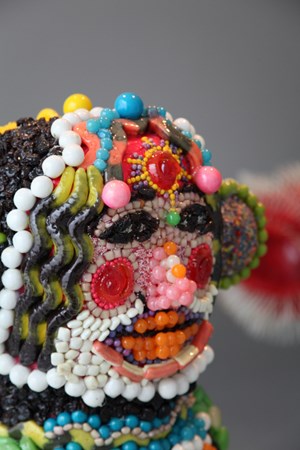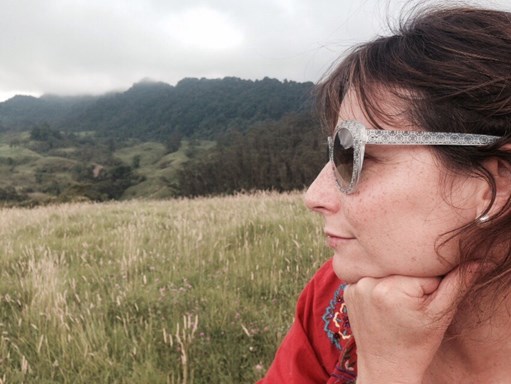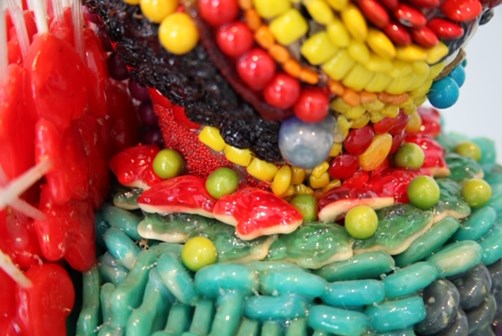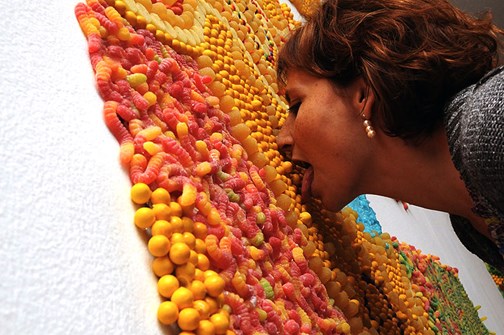
I am an artist based in Bogota – Colombia. I do art because is the only way I find a comfortable understanding of living. I use art to connect to the world. I do paintings because the language of color is my way to activate sensations and to move the emotional world. I believe that painting is something you may do with any material and on top of any surface, that’s why I create spatial paintings with accumulations’ of disposable materials, or painted objects, to create new perspectives or views on quotidian things and stuff from the world.
Image: Daugther, Candy Totem, 2011
Lina Sinisterra is a Colombian visual artist. She graduated in Psychology with a postgraduate in Psychodrama and a master’s degree in Visual Arts from the University of Chile. She workes as a professor, practice that she includes in her artistic career. Sinisterra is director of visual arts of Velatropa, an art collective that brings together arts and theater.
 Lina Sinisterra, courtesy to the artist
Lina Sinisterra, courtesy to the artist
Sinisterra participated in numerous group and solo shows in Latin America, Europe and Asia, including Chile, Venezuela, Colombia, Brazil, Madrid and Korea. She has won several awards: a public sculpture commission for the International Airport in Santiago, Chile, 2015; Santa Fe Gallery in Bogotá, Colombia, 2010; The Fondart, in Chile, 2006; The Gunther Biennial Prize on Painting in Chile, 1997. During her years as director of Velatropa, the project received various awards and fellowships.
ArtDependence (AD): Who are you and what do you do?
Lina Sinisterra (LS): I am an artist based in Bogota – Colombia. I do art because is the only way I find a comfortable understanding of living. I use art to connect to the world. I do paintings because the language of color is my way to activate sensations and to move the emotional world. I believe that painting is something you may do with any material and on top of any surface, that’s why I create spatial paintings with accumulations’ of disposable materials, or painted objects, to create new perspectives or views on quotidian things and stuff from the world.
I believe that every artistic intention or action is in resonance with the universe. And the process of art is a central energetic power to uplift the planet and beyond.
We are what we do! The future of humanity is to make a shift, to connect with intuition; painting is a vehicle for that. Neuroscientists have revealed lately that we have access of just 2 % of the information we keep in our unconscious, that domains all our actions. Art is a way to reconnect with the deepest knowledge of our selves and planetary information.
Producing art or looking at it is one of the channels to access to the intuitive knowledge. The future of humanity and nature is to make that shift from rationalism and positivist science (that destroyed our planet) into intuitive wisdom. We are all connected; we are one with the universe.
The process of art is an action that generates high energetic vibes, and that changes everything. I became aware of this after walking on fire for more that 40 minutes without burning my feet, just by uplifting my energy with dance and joy.
I create art that is connected with joy and happiness. Quantic physics explains and shows how thoughts and intentions are already creating changes in atomic and subatomic structures manifesting material movements before even a word is said.

Image courtesy to the artist
AD: Tell us about your work
LS: My work is intent to bring joy and happiness. My intent is to reconnect people with the playful-mode of childhood through the experience with colors and materials, bringing the inner child spirit alive.
In other words, My installations, paintings and performances of monumental dimensions and abundant colours have been my ruse to keep alive the drive of life, the pleasure principle and the ability to play; in a country dominated by violence and fear, my art proposes a safe place for me. I have been interested in materials that connect with my childhood sensations, such as sweets, cotton candy, gelatine, toys and atomized colors in paint.
The process (my destiny) like that of a personal diary marks my attempt to fill a "broken void" and the struggle to fulfill unattainable dreams. I created an “existentialist working mechanics”, where I play with a visual purpose, with the idea of failure, of being rejected, or of encompassing the unattainable; paradoxically this mechanics generate satisfaction and certainty in the process: Operations such as sticking 110,000 candies one by one, or knitting point to point a pictorial image, or bottling 14 thousand liters of anilines with a funnel, are roads that I choose as a destination that teaches me to accept the difficulties and to deal with human desires and contradictions (comer del arte quiero). My creative process is intuitive and consists on shaping the materials in a fractal growth, like a children's game that tries to fill a space....Which I always see empty.
In my installations I am interested in materials that are unstable to temperature or light conditions, because these changes are related to internal processes such as emotions. I understand the space (sites, canvas, molds or bodies) as a great void that I fill with my childhood fantasies, flavors, textures, colors and pleasurable sensations. Through this transmutation of the material world into a new form of existence, I not only re-create myself, but the cosmos too.
In “All destinations” (sculpture designed for Santiago de Chile’s international airport) I multiply 100 times the size of the typical plastic airplane known for being the one used in kids birthday parties, and placed them as flying on light posts, programed so that at night they seem to be flying in circles; poetically meaning they are not going anywhere, no matter how far you travel all destinations lead you to your self.

Daugther, Candy Totem, 2011
In the “survival sculptures” made with candies I intent to play with the desires embodied in the candy and the totem images, that paradoxically where created inspired on the difficulties for surviving while being an artist….wishing someday I could eat from art (comer del arte quiero).
AD: What’s your goal?
LS: To enjoy life and flow. To be owner of my time. To create things that contribute to the wellness of the planet and the psychological state of the mind.
AD: What is your dream project?
LS: To place all the dots I’ve painted in my life together in the same space and understand de dimension of a lifetime while experiencing them.
AD: Why do you do what you do?
LS: To be the owner of my lifetime, to be coherent between what I think life should be and what I do out of it. To survive despite times or difficulties.

Image courtesy to the artist
AD: What role does the artist have in society?
LS: Make the world a better place, activate awareness and provide aesthetic experiences to re-connect to the sublime universe.
AD: What themes do you pursue?
LS: Anything that activates the inner child, the pureness of the spirit, beauty, joy, happiness through the use and re-use of local objects charged with memories of a culture, through the experience of colors and the gesture that hands-on work represents in a technological world.
AD: What’s your favorite art work?
LS: It changes according to my mood, but I believe that I have in my unconscious mind always, the kiss from Klimt.
AD: What memorable responses have you had to your work?
LS: Once, at Galeria Santa Fe in Bogota, a very elegant and old man looked around to be sure no one was watching, and then he put his tongue in the candy piece to taste it.
I remember another time when doing performance in the street, I was creating hairstyles with cotton candy and a person with no arm, asked me to please create a cotton candy arm for him.

Eating art, image courtesy to the artist
AD: What do you dislike about the art world?
LS: I don’t like all the mediators that create discourses and speeches to explain art, and also don’t like people that need explanations to understand what they are directly observing or experiencing.
I believe art must be a personal and unique encounter between spectators and the oeuvre.
AD: What research do you do?
LS: I am an empiric anthropologist; I travel to different cultures and subcultures, to learn from people. I inspire my creations based on the perceptions that people have about their reality and their world. I research a lot on neuroscience, on the psychological implications of the modern world lifestyle.
AD: What’s the best piece of advice you’ve been given?
LS: “To think beautiful and walk with a happy heart”, words from Shaman Antonio from Putumayo Colombia
AD: What would you have done differently?
LS: Married the right person, being able to live a long and happy love story.

ArtDependence Magazine is an international magazine covering all spheres of contemporary art, as well as modern and classical art.
ArtDependence features the latest art news, highlighting interviews with today’s most influential artists, galleries, curators, collectors, fair directors and individuals at the axis of the arts.
The magazine also covers series of articles and reviews on critical art events, new publications and other foremost happenings in the art world.
If you would like to submit events or editorial content to ArtDependence Magazine, please feel free to reach the magazine via the contact page.